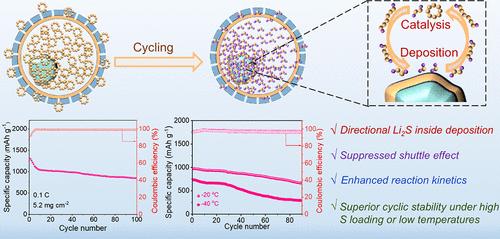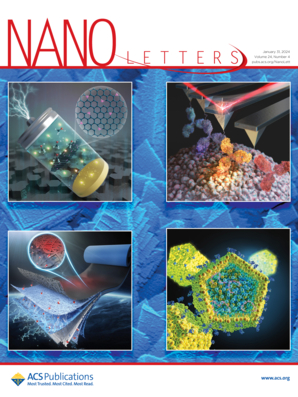Regulating Li2S Deposition and Accelerating Conversion Kinetics through Intracavity ZnS toward Low-Temperature Lithium–Sulfur Batteries
IF 9.1
1区 材料科学
Q1 CHEMISTRY, MULTIDISCIPLINARY
引用次数: 0
Abstract
The uncontrolled deposition behavior and sluggish conversion kinetics of the discharging product (solid Li2S) severely deteriorate the electrochemical performance of lithium–sulfur (Li–S) batteries, especially under high S loading and low-temperature conditions. Herein, a multifunctional S cathode host consisting of ZnS nanoparticles (NPs) confined in hollow porous carbon spheres (ZnS@HPCS) is synthesized via a unique capillary force-driven melting-diffusion strategy. The porous carbon shell of ZnS@HPCS provides a space-confined reservoir for soluble polysulfides and solid Li2S, while the intracavity ZnS NPs trap polysulfides, induce Li2S inside deposition, and accelerate conversion kinetics. Thus, Li–S batteries with ZnS@HPCS-S cathodes exhibit excellent electrochemical performance at both room and low temperatures (−40 °C) and high reversible capacities under high S loading (5.2 mg cm–2). Furthermore, Li2S nucleation/deposition, in situ Raman, and theoretical analyses reveal the underlying mechanism. This work offers fundamental insights into regulating Li2S deposition and designing S hosts for high-performance Li–S batteries.

通过腔内 ZnS 调节 Li2S 沉积并加速转换动力学,实现低温锂硫电池的目标
放电产物(固态 Li2S)不受控制的沉积行为和缓慢的转化动力学严重恶化了锂硫(Li-S)电池的电化学性能,尤其是在高 S 负载和低温条件下。本文通过一种独特的毛细管力驱动的熔融扩散策略,合成了一种多功能硫阴极宿主,该宿主由封闭在空心多孔碳球(ZnS@HPCS)中的 ZnS 纳米颗粒(NPs)组成。ZnS@HPCS 的多孔碳壳为可溶性多硫化物和固态 Li2S 提供了一个空间封闭的储层,而腔内 ZnS NPs 则捕获多硫化物,诱导 Li2S 在内部沉积,并加速转换动力学。因此,采用 ZnS@HPCS-S 阴极的锂-S 电池在室温和低温(-40 °C)条件下均表现出优异的电化学性能,并且在高 S 负载(5.2 mg cm-2)条件下具有高可逆容量。此外,Li2S 成核/沉积、原位拉曼和理论分析揭示了其基本机制。这项研究为调节 Li2S 沉积和设计高性能锂-S 电池的 S 宿主提供了基本见解。
本文章由计算机程序翻译,如有差异,请以英文原文为准。
求助全文
约1分钟内获得全文
求助全文
来源期刊

Nano Letters
工程技术-材料科学:综合
CiteScore
16.80
自引率
2.80%
发文量
1182
审稿时长
1.4 months
期刊介绍:
Nano Letters serves as a dynamic platform for promptly disseminating original results in fundamental, applied, and emerging research across all facets of nanoscience and nanotechnology. A pivotal criterion for inclusion within Nano Letters is the convergence of at least two different areas or disciplines, ensuring a rich interdisciplinary scope. The journal is dedicated to fostering exploration in diverse areas, including:
- Experimental and theoretical findings on physical, chemical, and biological phenomena at the nanoscale
- Synthesis, characterization, and processing of organic, inorganic, polymer, and hybrid nanomaterials through physical, chemical, and biological methodologies
- Modeling and simulation of synthetic, assembly, and interaction processes
- Realization of integrated nanostructures and nano-engineered devices exhibiting advanced performance
- Applications of nanoscale materials in living and environmental systems
Nano Letters is committed to advancing and showcasing groundbreaking research that intersects various domains, fostering innovation and collaboration in the ever-evolving field of nanoscience and nanotechnology.
 求助内容:
求助内容: 应助结果提醒方式:
应助结果提醒方式:


